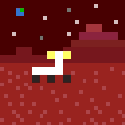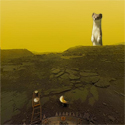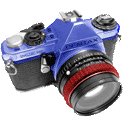|
...! posted:No, there were lines rather than dots and they were a slightly different shade of blue than the star. They also were packed very closely together. Floaters. Imperfections in the vitreous humour inside your eyeballs.
|
|
|
|

|
| # ? May 30, 2024 20:21 |
|
Phanatic posted:Floaters. Imperfections in the vitreous humour inside your eyeballs. This. No earth-based telescope has the resolving power to make out swirling gases on other stars. You need at least a $600 expenditure to even see that on the sun.
|
|
|
|
It could involve atmospheric distortion too, right? Sounded an awful lot like plain old "twinkling".
|
|
|
|
John Dobson died today. I was lucky enough to meet him in 1999. Chance encounter at an In 'n Out Burger while on a high school trip from Phoenix to California. I recognized him, and was sad I didn't have my telescope with me for him to sign. He was amused that a random 17 year old not only recognized him but was asking for his autograph. Sad day for amateur astronomers.
|
|
|
|
That's too bad. My Dad and I had a chance to meet him at the Table Mountain Star Party in WA. Dad got his 10" dob signed. Might have to get around to building my own now. Glad he had the chance to inspire so many.
|
|
|
|
AstroZamboni posted:John Dobson died today. I was lucky enough to meet him in 1999. Chance encounter at an In 'n Out Burger while on a high school trip from Phoenix to California. I recognized him, and was sad I didn't have my telescope with me for him to sign. He was amused that a random 17 year old not only recognized him but was asking for his autograph. Not many did as much to bring astronomy to the masses as him.
|
|
|
|
Today I got my first telescope in about 25 years, a Celestron 130eq-md, but sadly I think the mount is broken. Then again, I've never used an equatorial mount so I might be wrong. I hope I am. The problem is that while the RA slow-motion knob works just fine (with the motor unplugged at least but that's another story), the dec slow-motion knob just jams up as soon as I try to turn it. Spinning things around and looking at how the mechanism works, it's not a geared affair like the RA is, but uses a spring mechanism, and it looks to me like things are bent right out of whack. Here's a view from the underside:  The slow-mo control knob is out of shot to the top right and you can see that the next piece of metal, inside/under the mountisnt on axis with that, which I assume it should be? As it is, it's gauging a circle out of the metal in the middle of the picture. Am I boxing this bad-boy back up?  Edit: After a little bit of surgery, this is a pretty convincing bend:  Jiblet fucked around with this message at 20:05 on Jan 17, 2014 |
|
|
|
One other related but separate question, should I be able to twist the RA slow-mo knob while the motor drive is attached? Even with the MD off, it doesn't want to move and I don't want to force it. With the MD dettached, the RA knob moves nice and smoothly. It seems a bit of a fiddly job to attach/detach the MD while finding targets, am I dong this wrong?
|
|
|
|
I'm almost sure there's no way I'd be able to see this in the city with my 90mm Cassegrain, even if it was clear and not cloudy, but I'm excited nonetheless. Supernova in M82
|
|
|
|
EpicPhoton posted:I'm almost sure there's no way I'd be able to see this in the city with my 90mm Cassegrain, even if it was clear and not cloudy, but I'm excited nonetheless. Depends on which city. Brightness hasn't peaked yet and it's expected to reach 8th magnitude. I've seen M82 through 90mm scopes under some reasonably light polluted skies.
|
|
|
|
AstroZamboni posted:Depends on which city. Brightness hasn't peaked yet and it's expected to reach 8th magnitude. I've seen M82 through 90mm scopes under some reasonably light polluted skies. I'm pretty much in Downtown Seattle. Naked eye visibility is about 2.5-3 magnitude on a good night. I'll be giving spotting it a shot on Saturday if it clears up like it's supposed to.
|
|
|
|
I can't wait to see it. It's gonna be a rare clear winter night here, so I'm going to treat it like it's my only chance to see it. Hope it'll be clear near peak brightness, though!
|
|
|
|
How long do they usually last? Is it a matter of hours? Days? Weeks?
|
|
|
|
OMGVBFLOL posted:How long do they usually last? Is it a matter of hours? Days? Weeks? Should keep brightening for the next couple of weeks up to ~8 magnitude, then fade from view over the course of a month.
|
|
|
|
Phanatic posted:Floaters. Imperfections in the vitreous humour inside your eyeballs. OK, I tried viewing Jupiter tonight and had the same results as looking at that star. I get a bright white filled circle with random lines on it, some of which were moving, which I'm assuming are the floaters. That was at 25x magnification. At 50x magnification I don't see poo poo. Am I doing something wrong, is there something wrong with my telescope, or is there something really wrong with my eyes that I should have checked out?
|
|
|
|
...! posted:or is there something really wrong with my eyes that I should have checked out? I'm no astronomer but if you have even the slightest concerns about your eyes go see a ophthalmologist - your sight is worth the consulting fee. If you describe to them what you've described here (including the actual activity you're doing, not just the symptoms) they should be able to give you some answers.
|
|
|
|
...! posted:OK, I tried viewing Jupiter tonight and had the same results as looking at that star. I get a bright white filled circle with random lines on it, some of which were moving, which I'm assuming are the floaters. That was at 25x magnification. At 50x magnification I don't see poo poo. Am I doing something wrong, is there something wrong with my telescope, or is there something really wrong with my eyes that I should have checked out? Well, bright white filled circle with stripes (parallel) is certainly Jupiter. Wibblyness of the lines could be seeing?
|
|
|
|
Also, a Galileoscope is going to be realistically limited to around 40x max. Not a premium piece of kit by any means. You won't really be able to see detail on anything other than the moon.
|
|
|
|
We had our yearly public event in support of BBC Stargazing Live the other week, I took my 10" reflector and had my 5mm eyepiece on it, best seeing I can remember. Even at 240x the focus was crisp and there was zero atmospheric disturbance, I think that is the only night I have ever put that eyepiece in and not been disappointed. Of course now the 150 odd visitors who had a look through my scope are forever going to be let down by anything else. We don't get nights like that in south east England very often.
|
|
|
|
AstroZamboni posted:Also, a Galileoscope is going to be realistically limited to around 40x max. Not a premium piece of kit by any means. You won't really be able to see detail on anything other than the moon. I've clearly seen stripes on Jupiter at 60x with a refractor; 50x is possible.
|
|
|
|
Anyone get the new supernova? I read that it was binocular-visible.
|
|
|
|
Phanatic posted:Anyone get the new supernova? I read that it was binocular-visible. God drat raining here.
|
|
|
|
I think I might have seen it, but I might have been seeing M81. Going camping away from city lights this weekend, so I'm going to try again.
|
|
|
|
Phanatic posted:Anyone get the new supernova? I read that it was binocular-visible. It might be possible if you've got a really good pair of binoculars. It was in and out of my vision with my 8" scope, but then again I've got astigmatism. Part of the problem is its right up against a bright part of the galaxy, so it doesn't stand out as clearly as a star of the same brightness right next to the galaxy.
|
|
|
|
gender illusionist posted:Well, bright white filled circle with stripes (parallel) is certainly Jupiter. Wibblyness of the lines could be seeing? They weren't parallel and were oriented in different directions each time I looked. It looked exactly like the star I looked at a few days ago. I guess the telescope is just crap but it's supposed to be able to see some detail on Jupiter and also see the larger moons. The weird thing is that it works fine indoors; I can use it to read a clock in another room just fine (albeit upside-down, which I'm told is normal).
|
|
|
|
rolleyes posted:I'm no astronomer but if you have even the slightest concerns about your eyes go see a ophthalmologist - your sight is worth the consulting fee. If you describe to them what you've described here (including the actual activity you're doing, not just the symptoms) they should be able to give you some answers. My eyes seem fine; I'm just considering that it might be an (unlikely) possibility.
|
|
|
|
Saturn will be very close to the moon tonight. Gonna try and check it out when the moon rises in the AM.
|
|
|
|
Saw the supernova tonight. Very easy to see, even in moderately light polluted skies (Colorado Springs). Was observing with with a member of my club who lives right in my neighborhood and hauled out his C8. Kept me from having to drag out my dob. Absolutely loving amazing.
|
|
|
|
My second ever attempt at M31 from a couple of weeks ago when the moon was pretty close. Finally getting the hang of PixInsight now and managed to extract this from all the light pollution which I was quite happy with. About 10 minutes of 60+120s unguided frames. Poor framing, a couple of darks and no flats because I'm a still a noob.
|
|
|
|
So there are some big sunspots on the sun right now. They were easy to see using just solar eclipse glasses, so I decided to try projecting them with my telescope. The pictures are by no means fancy, but hey, I was able to see sun spots in real time. Link.
|
|
|
|
In H-alpha this group is best described as "a swirling vortex of doom." Terrifying and beautiful, with frequent flashes of m-class flares. Lots of fun to watch. In other news, I got some information from Bob Naye at Sky and Telescope. They have a backlog of observing articles right now, but my article will be published sometime between June and November. Pretty excited over here. Considering it's the first time I've submitted anything for publication and it got accepted on the first try (along with a decent check for my effort) I'm rather pleased. I've been writing how-to articles and reviews for Cloudy Nights for years, but this is the first time I've gotten paid to write about astronomy. Feels good, man! AstroZamboni fucked around with this message at 21:01 on Feb 3, 2014 |
|
|
|
I trawled the OP, but I didnt see any direct recommendations. I'm looking to purchase a first telescope and even with an amateur photography background the vast amount of different telescopes is overwhelming. Dobson scopes, newtonian, refractor, cassegrain I have a budget of around $500 and I've been looking at this telescope. All I've learned so far is that I probably want one with a GoTo or similar, and personally I'd like one which makes astrophotography a little bit easier, like having eyepiece adaptors for nikon/canon, but I'm really open to suggestions. Fishstick fucked around with this message at 20:49 on Feb 4, 2014 |
|
|
|
Fishstick posted:I trawled the OP, but I didnt see any direct recommendations. First of all, you probably don't want GoTo. Anything affordable doesn't have good enough mechanics to make it worth it. I have a 90mm Meade GoTo, and it's such a pain to do anything with the GoTo, I rarely use it. It's inaccurate, drifts over time, and is a pain to get calibrated. The biggest thing that will make your scope more awesome is aperture. The more mirror/lens space you can get, the better. The one you linked will do OK at planets, binary stars, and any of the bright interesting objects, like clusters, and some galaxies. If you're just learning how to do astronomy, I'd recommend getting a Dobsonian. They're dead simple, easy to maintain, cheap, and you can get a big rear end mirror in them for not much money. You can get as pricey as you like, or dirt cheap. Great for DIY if you're into that too. I'd shoot for about a 6" mirror. You'll have more observation targets than you can fathom, and you'll get great images once you start doing photography. For photography, what I'd recommend, is getting your dob, and then once you're comfortable finding objects, and want to start taking pictures (the other great thing about dobs is they are super customizable and you can bolt whatever the hell you want to them, so when it is time to swap out your eyepiece mount for one that you can strap a camera too, it won't be too much trouble) you can buy one of these guys. Equatorial Platform They are pretty cheap, won't prevent you from swinging the scope around like a maniac, dead simple, and easy to store. I've never owned one, but I've seen them at star parties, and they rock. Recommended $500 budget Setup: 8-Inch Orion Dob: $360 You'll probably want a couple other eyepieces as well, probably a 32mm and a 15mm. Scope comes with a basic 25mm (Lower mm = higher magnification) Super Plossl's are pretty good to start out with. Something like this: Meade Series 4000 Super Plossl Eyepieces Might be worth giving this a read to decide on which eyepieces to buy: Astronomical Telescope Eyepieces: A Discussion for the Beginner Red Flashlight Trust me, you'll need one. Turn Left at Orion I've recommended you choose an unguided telescope. This book will show you how to use it. I'd reccomend flipping through the "look inside this book" to take a look and see how it shows you how to find everything. Also look at the illustrations to see what you'll be able to see with a bigger dob, vs a smaller scope. Last Edit: Goddamnit you motherfucker now I'm gonna have to buy a new scope. What have you got me into.  Double Last Edit: Thought this was in the Spaceflight Megathread. Fishstick posted over there as well. It's been a while since I've been really doing much observing, so if anyone else has any better recommendations, please correct me. This is just what I've had the most fun with. EpicPhoton fucked around with this message at 22:57 on Feb 4, 2014 |
|
|
|
Your recommendations are spot on and I doubt any diehard amateur astronomers would disagree. One more thing I would suggest is the Pocket Sky Atlas from Sky Publishing. One of the best all around sky atlases on the market. Small and easily manageable, but comprehensive and will serve you well for a long time. Also: adjustable height observing chair. You can build one yourself for about 30 bucks (google "denver observers chair" because there are lots of variations and online blueprints). Your back will thank you.
|
|
|
|
Cool. Then I just need to follow my own advice, ditch my tiny Meade and get me a proper scope. Oh, and find storage for a 8 inch dob in my 1 bedroom apartment.
|
|
|
|
I figure you guys would probably be able to help with this. I'm on a small project team at my university and was assigned by the professor who is project-lead to trawl the internet for ideas. We're trying to get decent photographs of 3 very small satellites in a polar orbit (here's the tracking data for one of them: http://www.n2yo.com/satellite/?s=39269). Since they are traveling so fast (only visible for short amounts of time, 15-20 minutes typically), and they are so small and dim (10cm diameter spheres, estimated visual magnitude ~11), we don't appear to have good enough equipment to get the kind of pictures we want. One of the main things we would like to do with this project is get a network of amateur astronomers around the globe to help us track these objects' orbital decays over the next 10 years, but obviously that might be a pipe dream seeing as we don't even have the ability to currently track them to the precision that would be useful. Do any of you have any equipment combinations/recommendations that we could try out to see if we get better results? We've talked about using a wider-angle lens to give us more time in the FOV as they pass over, but it appears to be difficult to get enough light from the satellites compared to the surrounding stars and the CCD we have apparently auto-removes things it thinks are anomalies when left open long enough. If we can keep it low-cost as well, that would certainly help us get the amateur network up and running, but any ideas are good ideas at this point. Or even if any of you wants to try spotting them yourselves, that's cool too, and I'd love to hear about or see your results.
|
|
|
|
EpicPhoton posted:
Yeah I originally posted in the spaceflight thread, didn't know there was one in the DIY forum. Anyway, thanks for the advice, now that I know what to look for. The only real con to a dobsonian for me is the bulkiness/portability.
|
|
|
|
pwnyXpress posted:I figure you guys would probably be able to help with this. I'm on a small project team at my university and was assigned by the professor who is project-lead to trawl the internet for ideas. We're trying to get decent photographs of 3 very small satellites in a polar orbit (here's the tracking data for one of them: http://www.n2yo.com/satellite/?s=39269). Since they are traveling so fast (only visible for short amounts of time, 15-20 minutes typically), and they are so small and dim (10cm diameter spheres, estimated visual magnitude ~11), we don't appear to have good enough equipment to get the kind of pictures we want. What about using a modern day DSLR or mirrorless with a fastish wide angle? Something like a d7100 or OM-D with a 50/1.4 lens or equivalent? Basically something where you can jack the ISO up to something nuts, 12800 or something. You can get some solid results with modern cameras at that iso. This shot was with an OM-D E-M5 at 12800 iso, using a 15mm f/4.5 lens, for 20 seconds. With a faster lens you might be able to pick out something that dark with the right processing techniques, namely turning off any in camera noise reduction and shooting in raw. Then you can boost the exposure in post, up the contrast maybe, and then cycle through consecutive shots to try and pick out the trail of the satellite. Would really help if you're in as dark as place as possible though.  milky way test by MrDespair, on Flickr
|
|
|
|
pwnyXpress posted:I figure you guys would probably be able to help with this. I'm on a small project team at my university and was assigned by the professor who is project-lead to trawl the internet for ideas. We're trying to get decent photographs of 3 very small satellites in a polar orbit (here's the tracking data for one of them: http://www.n2yo.com/satellite/?s=39269). Since they are traveling so fast (only visible for short amounts of time, 15-20 minutes typically), and they are so small and dim (10cm diameter spheres, estimated visual magnitude ~11), we don't appear to have good enough equipment to get the kind of pictures we want. Nice try. Kim Jong Un can do his own drat surveillance.
|
|
|
|

|
| # ? May 30, 2024 20:21 |
|
Mr. Despair posted:What about using a modern day DSLR or mirrorless with a fastish wide angle? Something like a d7100 or OM-D with a 50/1.4 lens or equivalent? Basically something where you can jack the ISO up to something nuts, 12800 or something. You can get some solid results with modern cameras at that iso. I haven't worked with one of those cameras, but I'm not sure if even that will be suitable. I'm assuming the project is measuring drag effects on the satellite. For accurate measurements they'll need to minimize the effects of the satellite's orbit as much as possible, and to do that they'll need *short* exposures. I'm not sure that will pick up a fast-moving 11th magnitude or fainter object. They'll probably need a CCD hooked to a telescope to do anything useful.
|
|
|






















